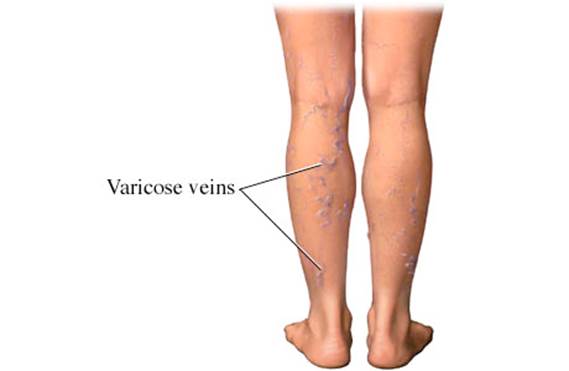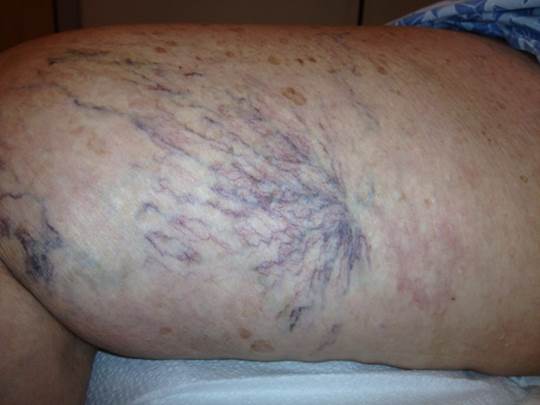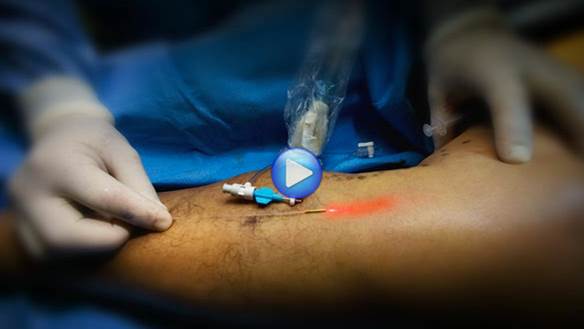Although largely harmless, varicose
veins can be painful and unsightly. We seek expert advice on the symptoms,
causes and treatments
If you've got veins on your legs that are
twisted, bluish and swollen, it's likely you're one of many Australians who has
developed varicose veins. This condition, which affects around 30 per cent of
women and 20 per cent of men, occurs when the tiny valves in your veins don't
work properly, allowing blood to flow backwards and causing the veins to
balloon. Although they’re largely harmless, varicose veins can be unsightly and
embarrassing. Associate Professor Kurosh Parsi is a phlebologist (the branch of
medicine that deals with veins) and head of the Department of Dermatology at St
Vincent's Hospital in Sydney. We asked him why varicose veins occur, who is at
risk, and how to get rid of them.

Varicose
veins can be painful and unsightly
1.
Anyone can get them
Although you can usually spot varicose
veins on the surface of the skin, sometimes they're not visible at all. They do
tend to run in families, but there are definitely environmental factors which
can cause varicose veins too, including occupations where you stand up a lot.
Other reasons varicose veins can occur, or
get worse, include damage to veins because of a leg injury, pregnancy,
fluctuations in Oestrogen levels during puberty or menopause, breastfeeding,
oral contraceptives, hormone replacement therapy and wearing high-heeled shoes.
Even if you have the gene you might not develop varicose veins, but combined
with environmental factors, they may still occur.
2.
There are other symptoms too
Common symptoms of varicose veins include
aching legs, or a feeling of heaviness, cramps, calf tenderness and restless
leg syndrome, all of which get worse as the day goes on. About 50 per cent of
people have no symptoms at all.
General leg pain can be the result of
arthritis or a muscular issue, whereas pain from varicose veins is always much
worse at the end of the day. This is usually because people have been standing
all day, which sends the blood down their legs, where it accumulates in the
calves, making the legs feel heavy. This type of pain tends to ease when you
raise your legs.
3.
Spider veins often go hand in hand with
varicose veins
If you have varicose veins, you may also
have clusters of spider veins. Normally these veins are hidden under the skin,
but when you can see them it's usually because the valves in the larger veins
aren't working properly and blood is flowing back into capillaries, making them
congested.

Spider
veins often go hand in hand with varicose veins
For many people, the appearance of spider
and varicose veins is their main concern. Although treatments for spider veins
such as cosmetic laser therapy and injecting a solution into the veins can work
in the short term, they're not a permanent solution. If you are going to treat
spider veins properly, you first need to treat the underlying cause. Cosmetic
solutions won't work because the spider veins are being fed by larger veins and
will therefore keep on returning. You need to treat the varicose veins first,
and the spider veins later.
4.
Why diagnosis is important
Having the condition diagnosed properly can
help you avoid other problems later on. Treatment becomes even more urgent if
there are existing issues such as phlebitis - an Inflammation of the veins -
blood clots in the legs, dermatitis or ulcers. And if you're planning to get
pregnant, It's a good idea to treat any varicose veins first, since
complications such as clotting and bleeding can develop during pregnancy.
Varicose veins that have worsened during
pregnancy also may not fully recover after you give birth, requiring more
involved and complicated treatment.
5.
Latest treatments
It's good to know that having veins treated
is much easier early on when the veins are smaller.
In the past, the problematic veins were
stripped from the leg, but it was an invasive procedure with a longer recovery
period and a higher failure rate. Today, for larger veins, a non-surgical laser
procedure called endovenous laser ablation (EVLA) is used.
The vein is accessed using a very fine
catheter at a single entry point. The catheter is moved up towards the groin,
guided by ultrasound. As the catheter is pulled out, the vein is sealed off.

Endovenous
laser ablation (EVLA)
Sclera therapy remains the gold standard
procedure used to treat superficial veins such as spider veins, and ultrasound
guided sclera therapy (UGS), using a foam chemical agent, is used to treat
slightly larger branch varicose veins. This involves injecting the foam into
the vein. The foam pushes the blood out and fills the vein, causing the vein to
spasm and scar, sealing it off. In principle, however, larger veins need to be
treated first with EVLA.
Parsi advises that Medicare rebates are
available for EVLA and UGS for up to six treatments per year.
6.
Making sure they don’t recur
Recovering from sclera therapy is
relatively easy and may involve wearing compression stockings, and to avoid the
veins returning you may need more than one treatment.
If you’re treated with the endogenous
laser, you will need to wear compression stockings for up to six weeks, walk
every day, and avoid heavy exercise. To stop these veins from coming back, on
average, you’ll need about three very precise treatments one or two weeks
apart.
If you suspect you have varicose veins, see
your doctor before they become a major issue. They are not a cosmetic problem,
and the earlier you have them fixed the better.